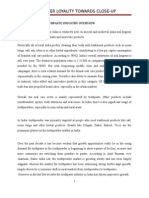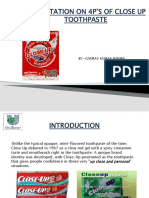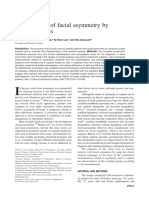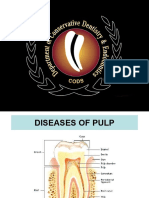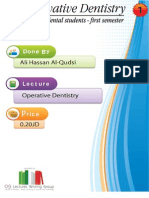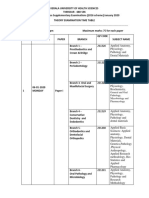Toothpaste History
Toothpaste History
Uploaded by
Tavleen89Copyright:
Available Formats
Toothpaste History
Toothpaste History
Uploaded by
Tavleen89Copyright
Available Formats
Share this document
Did you find this document useful?
Is this content inappropriate?
Copyright:
Available Formats
Toothpaste History
Toothpaste History
Uploaded by
Tavleen89Copyright:
Available Formats
Toothpaste History The development of toothpaste began as long ago as 300/500BC in China and India.
According to Chinese history, a learned man, Huang-Ti, studied the care of teeth and claimed different types of pain felt in the mouth could be cured by sticking gold and silver needles into different parts of the jaw and gum. It was theories such as these that led to the development of dental cream. First attempts at tooth cleaning included using abrasives such as crushed bone, crushed egg and oyster shells, which were used to clean debris from teeth. Tooth powders were the first noticeable advance and were made up of elements like powdered charcoal, powdered bark and some flavouring agents. This would be applied to teeth using a simple stick. Toothpowder or dentifrice was first available in Britain in the late eighteenth century. It came in a ceramic pot and was available either as a powder or paste. The rich applied it with brushes and the poor with their fingers. Modern toothpastes were developed in the 1800s. A dentist called Peabody was the first to add soap to toothpaste in 1824. Chalk was first added to toothpaste by John Harris in the 1850s. In 1873, toothpaste was first mass-produced into nice smelling toothpaste in a jar. In 1892, Dr. Washington Sheffield of Connecticut was the first to put toothpaste into a collapsible tube. Sheffield's toothpaste was called Dr. Sheffield's Creme Dentifrice. Advancements in synthetic detergents (after World War II) replaced the soap used in toothpaste with emulsifying agents such as Sodium Lauryl Sulphate and Sodium Ricinoleate. The 1960's saw the introduction of fluoride into toothpaste. This development was followed in the 1980's with the addition of soluble calcium fluoride to fluoride toothpastes. It is therefore within the last thirty years that toothpastes contains the two ingredients - calcium and fluoride. Nowadays, there are controversial views on the effectiveness and safety of fluoride toothpaste. For those who are safety concious, the use of natural toothpaste might be a better choice.
The toothpaste history in India can be tracked back from 1975 with 1200 tonnes of toothpaste produced by the toothpaste industry. Prior to the toothpastes Oral Hygiene was the domain of local home made powders and ayurvedh practitioners. With the entry of Colgate in Indian marketplace the awareness about Oral care and the importance of oral care. In recent years the Industry has shown impressive growth rate of 18.6% (this growth is calculated in terms of value growth in Rs. ). The growth in the Urban market has been largely by the Gel Segment. Presently, a large chunk of the Market is still held by Colgate. The major players in the toothpaste Industry being Colgate Palmolive and Hindustan Lever Limited and several minor players like Balsara hygiene, Dabur etc. Presently Colgate Dental Cream holds 52% of market share. HLLs Close up lies far behind with 23% of the existing market share. The third player in the
marketplace in terms of market share is Colgate Gel with 10.5% of the market share. That leaves 14.5% market share for other Brands like Pepsodent, Pepsodent G, Promise, Babool, Sensofoam, Forhans, Cibaca, Neem, Vicco etc. The toothpaste market is presently valued at Rs. 750 crores out of which the Gel segment has already bagged 1/3rd portion of it. The Gel segment presently stands at Rs. 248 crores and is growing at a rate much faster than Cream. In India toothpaste usage as compared to other countries is very low which signifies about the potential of the market. In Urban India the usage of toothpaste per person per year is just 190gms. Where as it is 200gms of toothpaste per person per year in developing countries as Indonesia and Thailand. In developed countries as USA and other European countries the toothpaste usage is 375 gms per person year. In India the toothpastes companies are going in for advertising on a heavy note, on an average the companies managing this FMCG category are spending 6.15% of their sales on development. Colgate Palmolive had shelled out 15% of their sales on ads in the year 1994. Dabur had an ad expenditure of 5.07% for the year 1993. whereas balsara Hygiene spend a huge 10.17% of their sales. TOOTHPASTE COMPANIES AND TOOTHPASTE BRANDS (1) Company : Shri Niranjan Aurvedh Bhawan, Tumsur (Mah) Product Range : Niranjan (a) 200 gm Tube Rs (b) 100 gm Tube Rs (c) 50 gm Tube Rs Segmenting Factor : Veg. / Non-veg. Population Target : 20% educate customers that all toothpastes have di-calcium phosphate or bone ash which is animal based. Whereas they use calcium rich PIPAL insted. Availability : Maharastra Distributors : 107 (newly appointed) Positioning Stance : Yoga For Teeth. Direct Competitor : Vicco Vajradanti, but they feel that will beat them in the price game as VICCOs 200 gm tube for Rs 44. (2) Company : Hindustan Lever Limited Brand Name : Close Up Marketed By : Hindustan Lever limited (HLL) Product Range : Close Up (Red, Green, Blue) 50 gm Rs 100 gm Rs 150 gm Rs Pepsodent : 50 GM Rs
100 GM Rs 200 GM Rs Pepsodent G : 50 gm Rs 150 gm Rs Segmenting Factor : Age Targeted At : Young people. The target market being Multi Brand Households where young does not use what their parents. This particular targeting was significant when Close Up was launched because Colgate positioning was a sort of Flip flop between Tooth decay and Bad Breath and Colgate was going for a Broad market constituting of all the age groups. Sought to be perceived by the customers was Fresh Breath. The physical appearance by the users, the Bright Red Gel synerized well with the Fresh breath Benefit. The advertising account was handled by LINTAS which focused on Fresh Breath that brought teenagers closer. By 1980 Close Up had 3% of the 16,000 tonnes toothpaste market. The production capacity was doubled through a deal with third party manufacturer and the Brand was taken National over the next year and a half, the Premium slashed by 30%. In 1983 Colgate started fearing after witnessing a downfall in market share and started airing its campaign by inviting customers into its Dental ring of confidence, by stressing more on breath and posing as a complete toothpaste. Close Up countered this move by sharpening product benefits, while urging the customers to do the HA test by blowing air on the palm, the message was that Close Up feels a lot cooler which reiterated the basic benefit of a fresh breath. 1987 was a Probe into Problem year for HALL as Close Up was much below expectations with only 4.5% of the 32,000 tonnes toothpaste market. They identified two basic problems: (1) Appearance of Toothpastes detracts prospects from its serious buyers. (2) Commercials displayed too much of proximity between couples which was too much for a mother, who actually purchased the Toiletries. 1998 Lever reworked 3 Ps in its Marketing mix in Tamil Nadu where people have a strong sense of Oral Hygiene and the area has a cost effective media Reach. The three reworked Ps are as follows: (1) Product : Blue mint flavour introduced. Tangerines of Read reduced. (for serious buyers.) Soft Squeeze lamitubes for toothpastes introduced for the first time in the country. (2) Communication Advertisement focus moved from spotlight to Gregarious couples. This group orientation was more acceptable to the Mother. (3) Distribution
Took Brand to Sub Urban and Rural areas. Posters and Mobile Vans arrived in areas where Urban lifestyle was a matter of aspiration. This was a purposeful move as the company did not want the Brand to be saddled with a restrictive. Up market image In the year 1990, Colgate followed Close Up by launch of its Blue Colgate Gel. It was targeted at the youngsters within its Brand fold who were seeking Freshness. It was priced at par with Close Up gel. The Colgate ad showed a fluorescent Blue spiral round the users body and it talked of Fresh Breath Energy. By this time Gel became the Battleground in order to become the leader because: * There is rapid expansion in gel segment. * Youngsters thought white paste to be outdated. In 1991, Close Up launched Zing Green and simultaneously Lever sponsored Close Up Sangeet Muquabala targeted at the rural youth. In 1991 Close Ups market share increased to 16% of Rs 377 crores per year market. 1991 witnessed a few problems for Close Up Blue, which was faltering on repeat purchases as customers did not perceive much freshness value in it. In 1992, HLL launched AQUA BLUE with added attributes like increased Mouthwash contents and a more Minter flavour, so that customers perceived benefit is Freshness which is Levers Positioning stance. In response Colgate introduced Red Actirinse and then Colgate Blue. People at HLL thought to counter Colgates growth by cashing in on Medicinal appeal and came out with Pepsodent with Germicheck snf Mentadent G now renamed as Pepsodent G for Gum problems. Colgate countered this move by launching Colgate Total as an advanced paste to fight. Tartar, Gingivitis, and other Dental ailments. 1993 was the year when HLL tried to woo the customers by innovative packaging. Firstly it introduced Stand Up Pump dispensers for metros but it bombed in the market because of High price perception as compared to benefits. Sachets formula was used by lever to break into Colgates fort. The Close Up sachets was priced at Rs. 3 per unit and it offered 20 uses, which means that a family of five could use it four times each. The year it sponsored zee Close Up Antaksharee. HLL also went in for Close Up Toothbrushes under the Brand name Confident and launched it in Tamil Nadu. The confident toothbrushes were taken National and most importantly HLL advertisement account shifted from LINTAS to FTA due to Global alignment move by Levers parent Unilever. The brief given to the new agency was to Strengthen the Audiences perception of Brands functional values.
Toothpaste Market in India
Synopsis (part) of our research on toothpaste market in India.
o Toothpaste market in India is worth Rs 2200 Crore (2006). o In India, per capita toothpaste consumption stood at 74g in 2005, which is amongst the lowest in the world, compared to 350g and 300g in Malaysia and Vietnam respectively. o Toothpaste enjoys a country wide penetration level of 50%. o Rural: o Urban: 75% o Oral hygiene continues to be under aggressive competition, with sales increasing by a modest 3% in current value terms in 2006 to Rs. 2,400 crs. Toothpaste accounted for a whopping 83% of value sales. o HLL's market share in the dental care market has grown from a mere five per cent in 1979 to an impressive 36 per cent today, whereas ColgatePalmolive has been seen its market share decline from a dominating 75 per cent to a struggling 56 per cent. Segments: Popular Segment Low Price Packs Niche Products Freshness Segment Growing Colgate Dental Cream, Pepsodent Cibaca, Babool Colgate MaxFresh,Close Declining Growing Up,Anchor Gel 39%
Ayurvedic and Sensitive toothpastes Stagnant
Price-based Segments: Regular Segment: Low Price Segment: 100 gm: Rs 25-30 100 gm: Rs 14-20
o The Lower Price Point segment accounts for around 25% of total category volumes. Small and regional brands from the low priced segment are expected to perform well because they are often close to the market, respond faster to changes and are willing to learn from mistakes. Colgate o Colgate has been present in the domestic oral care market (of India) for the last 70 years. o A dominant position in the toothpaste segment with a 48% market share in the domestic market. o 1.5 times the second largest player. o Cibaca was acquired by Colgate in 1994 from Ciba Geigy. o The company today has two main brands in the toothpaste segment ' Colgate and Colgate Cibaca. o Colgate Cibaca has risen to become the 4th largest paste brand in the country in volume terms after Colgate Dental Cream, Pepsodent and Close-Up
Pepsondent o Brand of Hindustan Unilever Ltd (HUL, erstwhile HLL) o In a declining toothpaste market, HLL has managed to grow its brands and this has been attributed to Pepsodents value proposition being redefined. o Pepsodents share has been climbing steadily from 15.5 per cent in the last quarter of 2002 to 16.3 per cent in the quarter ending June 2006. o HLL's Dental insurance scheme, being launched through a partnership with the New India Assurance, offered a dental insurance of Rs 1,000 on purchase of any pack of Pepsodent. Anchor o Anchor belongs to Anchor Health and Beauty Care (AHBC), a part of the Anchor Group (makers of Anchor Electrical switches). o Anchor White Toothpaste was positioned as Indias first British Dental Health Society certified 100 per cent vegetarian toothpaste, in 1997. o Anchor and Ajanta price their offerings at more than 40% discount, giving the market leaders a run for their money. These low priced competitors accounted for more than 80 per cent of the growing 'discount segment'. Top 5 Brands - Market Share (2006) 1. Colgate Dental Cream 34%
2. Close-Up 4. Colgate Cibaca Top
14% 5.7% 3% 32.3%
3. Pepsodent Complete 10 11% 5. Colgate Fresh Energy Gel 6. Other Brands
a. Anchor, Babool, Ajanta, etc Company 1. Colgate Palmolive Ltd: 2. HLL: 3. Dabur: 7.2% Market Share (Value), 2006 47.3% 30%
You might also like
- The Greenwash Effect: Corporate Deception, Celebrity Environmentalists, and What Big Business Isn?t Telling You about Their Green Products and BrandsFrom EverandThe Greenwash Effect: Corporate Deception, Celebrity Environmentalists, and What Big Business Isn?t Telling You about Their Green Products and BrandsNo ratings yet
- Unit 6 Standard TestDocument2 pagesUnit 6 Standard TestYONo ratings yet
- Environmental Groups in AlbaniaDocument1 pageEnvironmental Groups in AlbaniaAnonymous 6qaFbHIrONo ratings yet
- The PassiveDocument21 pagesThe PassiveMercedes López Portillo100% (1)
- Bai Tap Tieng Anh Thi Hien Tai Hoan Thanh PDFDocument4 pagesBai Tap Tieng Anh Thi Hien Tai Hoan Thanh PDFEli LiNo ratings yet
- 1 On Screen b1 Sety Leksykalne Mod2 InteraktywnyDocument1 page1 On Screen b1 Sety Leksykalne Mod2 InteraktywnyDanuta KochanowiczNo ratings yet
- Consumer Buying Behaviour Towards Toothpaste Brands - Toothpaste Industry Overview, Toothpaste Companies, Toothpaste Brands, CoDocument7 pagesConsumer Buying Behaviour Towards Toothpaste Brands - Toothpaste Industry Overview, Toothpaste Companies, Toothpaste Brands, CoRamasubbareddy ChallaNo ratings yet
- Toothpaste IndustryDocument9 pagesToothpaste IndustrySiva KumaravelNo ratings yet
- Business Research Methodology: Group No 2Document10 pagesBusiness Research Methodology: Group No 2Jojo DiazNo ratings yet
- Close Up Marketing MixDocument29 pagesClose Up Marketing MixRushabh Mehta94% (17)
- Close Up Marketing MixDocument28 pagesClose Up Marketing MixDzaky Ulayya100% (1)
- CloseupDocument22 pagesCloseupPhorum TopraniNo ratings yet
- Close Up Marketing Mix Sem 3Document21 pagesClose Up Marketing Mix Sem 3Rajalaxmi DevendraNo ratings yet
- Project On ToothpasteDocument31 pagesProject On ToothpasteRoyal Projects89% (28)
- A Report On Consumer Behaviour Towards Colgate Colgate Palmolive (I) LTDDocument22 pagesA Report On Consumer Behaviour Towards Colgate Colgate Palmolive (I) LTDGundupagi ManjunathNo ratings yet
- Chapter - 1: Toothpaste Industry: An OverviewDocument31 pagesChapter - 1: Toothpaste Industry: An OverviewAshutosh DalmiaNo ratings yet
- Chapter - 1: Toothpaste Industry: An OverviewDocument30 pagesChapter - 1: Toothpaste Industry: An OverviewKIPLANGAT BETT100% (1)
- Colgate PresentationDocument29 pagesColgate PresentationBala KrishnanNo ratings yet
- Indian Oral Care Industry - Industry ReportDocument8 pagesIndian Oral Care Industry - Industry ReportGnanashre100% (1)
- Key Facts: Brooke Bond Is One of The Most Promising and Profiteering Brands Under Hindustan LeverDocument6 pagesKey Facts: Brooke Bond Is One of The Most Promising and Profiteering Brands Under Hindustan LeversaravanasanuNo ratings yet
- Colgate NeemDocument3 pagesColgate NeemManan ChandaranaNo ratings yet
- Colgateppt 091201144928 Phpapp02Document27 pagesColgateppt 091201144928 Phpapp02Aditya MishraNo ratings yet
- Colgateppt 091201144928 Phpapp02Document28 pagesColgateppt 091201144928 Phpapp02ridhamayankNo ratings yet
- Study On The Oral Care Industry in IndiaDocument4 pagesStudy On The Oral Care Industry in IndiaAnantha NagNo ratings yet
- Colgate Is An American Brand Principally Used For Oral Hygiene Products Such As ToothpastesDocument6 pagesColgate Is An American Brand Principally Used For Oral Hygiene Products Such As Toothpasteshappy singhNo ratings yet
- ProjectDocument50 pagesProjectMANKARAN SINGH BHATIA 21-22No ratings yet
- Presentation On Colgate: By:Vaibhav Chaware Sub: IMCDocument28 pagesPresentation On Colgate: By:Vaibhav Chaware Sub: IMCVaibhav ChawareNo ratings yet
- Colgate Case StudyDocument13 pagesColgate Case StudyVishal MalhiNo ratings yet
- Colgate Vs PepsodentDocument22 pagesColgate Vs PepsodentShihab Khan0% (1)
- Pepsodent Vs ColgateDocument23 pagesPepsodent Vs ColgateMohit Choudhary100% (1)
- Colgate Presentation: Mayur Pathak Tejas Gohel Kevin Chitroda Jaydeep Shah Nirmal Sakarani Ashwin IyengarDocument34 pagesColgate Presentation: Mayur Pathak Tejas Gohel Kevin Chitroda Jaydeep Shah Nirmal Sakarani Ashwin Iyengarkevin_c11No ratings yet
- Close Up 4 PsDocument17 pagesClose Up 4 PsSatish Tayal100% (2)
- ColgateDocument20 pagesColgateArnab BanerjeeNo ratings yet
- Introduction of Colgate PalmoliveDocument12 pagesIntroduction of Colgate PalmoliveDilip SarojNo ratings yet
- Comparitive Study Colgate and PepsodentDocument10 pagesComparitive Study Colgate and PepsodentSunil MathewsNo ratings yet
- Comparative Analysis ofDocument6 pagesComparative Analysis ofTejas PunmiyaNo ratings yet
- Brand Dossier-Colgate PalmoliveDocument40 pagesBrand Dossier-Colgate Palmolivejaskaran1991singh67% (3)
- ColgateDocument9 pagesColgatepuneet71988No ratings yet
- Colgate Vs PepsodentDocument21 pagesColgate Vs PepsodentNikhil Agrawal100% (1)
- COLGATE Vs PEPSODENTDocument22 pagesCOLGATE Vs PEPSODENTAbhijeet Kulshreshtha78% (9)
- PepsodentDocument2 pagesPepsodentparulNo ratings yet
- Colgate Vs P&GDocument7 pagesColgate Vs P>ressaJoyNo ratings yet
- Colgate SuperbDocument44 pagesColgate SuperbSohel BangiNo ratings yet
- Colgate PalmoliveDocument7 pagesColgate PalmoliveAbs PangaderNo ratings yet
- Colgate Marketing PlanDocument22 pagesColgate Marketing Plancoolaysuh9No ratings yet
- Report On Tooth PasteDocument23 pagesReport On Tooth PasteAnkit TyagiNo ratings yet
- Chapter1 IntroductionDocument20 pagesChapter1 Introductionselwyn999No ratings yet
- ColgateDocument30 pagesColgateShailja SinghNo ratings yet
- MM Project Colgate ToothpasteDocument27 pagesMM Project Colgate ToothpasteJagan PanathaleNo ratings yet
- Presentation On Marketing Strategies of Colgate ToothpasteDocument16 pagesPresentation On Marketing Strategies of Colgate ToothpasteTanushree_Razd_215No ratings yet
- ColgateDocument20 pagesColgateurjanagarNo ratings yet
- ColgateDocument4 pagesColgateDhanush GowravNo ratings yet
- Colgate Palmolive Marketing CaseDocument13 pagesColgate Palmolive Marketing CasenesninisNo ratings yet
- Apex Report Sub Group Component Group10 V2Document18 pagesApex Report Sub Group Component Group10 V2Athreya Nagarjuna MNo ratings yet
- ColgateDocument25 pagesColgatePratibha Jha100% (1)
- Colgate and PepsodentDocument24 pagesColgate and PepsodentSneha ShuklaNo ratings yet
- Colgate Brand: Prepared byDocument20 pagesColgate Brand: Prepared bykrunalNo ratings yet
- Toothpaste and Soaps ProjectDocument13 pagesToothpaste and Soaps ProjectAnkita123456780% (4)
- Greenwashing in the Fashion Industry - The Flipside of the Sustainability Trend from the Perspective of Generation ZFrom EverandGreenwashing in the Fashion Industry - The Flipside of the Sustainability Trend from the Perspective of Generation ZNo ratings yet
- Citizen Brand: 10 Commandments for Transforming Brands in a Consumer DemocracyFrom EverandCitizen Brand: 10 Commandments for Transforming Brands in a Consumer DemocracyNo ratings yet
- Class Ii Lower Premolar Mod Amalgam Preparation & RestorationDocument4 pagesClass Ii Lower Premolar Mod Amalgam Preparation & RestorationKizzy SarriaNo ratings yet
- Bosnia and HerzegovinaDocument2 pagesBosnia and HerzegovinaAnonymous G4VuCbNo ratings yet
- Daftar Nama Buku Bidang Ilmu Lengkap (Update BLN Agustus)Document11 pagesDaftar Nama Buku Bidang Ilmu Lengkap (Update BLN Agustus)kameliaNo ratings yet
- A Review of Root Fractures Diagnosis Treatment and PDFDocument10 pagesA Review of Root Fractures Diagnosis Treatment and PDFMinh Nhat Le ThanhNo ratings yet
- Tooth EruptionDocument12 pagesTooth EruptionibrahimNo ratings yet
- Mini ImplantsDocument111 pagesMini Implantsdr.vishnuNo ratings yet
- Classification of Facial Asymmetry by Cluster Analysis: Original ArticleDocument6 pagesClassification of Facial Asymmetry by Cluster Analysis: Original Articlesajida khanNo ratings yet
- Single Visit EndodonticsDocument6 pagesSingle Visit EndodonticsSerene Kenny100% (1)
- Banchs Trope JOE 2004Document5 pagesBanchs Trope JOE 2004digdouw100% (1)
- Diseases of PulpDocument81 pagesDiseases of PulpDrMohit Sharma100% (1)
- Vinyl Polysiloxane Impression Material in Removable Prosthodontics Part 1: Edentulous ImpressionsDocument9 pagesVinyl Polysiloxane Impression Material in Removable Prosthodontics Part 1: Edentulous ImpressionsLuis Salvador Martinez Estrada0% (1)
- Principles of Complex Exodontia: Oral Surgery IIDocument45 pagesPrinciples of Complex Exodontia: Oral Surgery IIRayne GelleNo ratings yet
- Lingual Set UpsDocument111 pagesLingual Set UpsNamshi AhamedNo ratings yet
- EMI. Khademi, ClarkDocument11 pagesEMI. Khademi, ClarkMaGe IsTeNo ratings yet
- SavedrecsDocument48 pagesSavedrecsRosaNo ratings yet
- Anatomy and Physiology in Relation To Complete Denture ConstructionDocument5 pagesAnatomy and Physiology in Relation To Complete Denture ConstructionSaraMAminNo ratings yet
- Lecture 1, Operative Dentistry (Script)Document12 pagesLecture 1, Operative Dentistry (Script)JustDen09100% (3)
- Bohara Et Al 2017 Stress Distribution and Displacement of Maxillary Anterior Teeth During en Masse Intrusion andDocument8 pagesBohara Et Al 2017 Stress Distribution and Displacement of Maxillary Anterior Teeth During en Masse Intrusion andAadhirai GopinathNo ratings yet
- Multi-Unit Implant Impression Accuracy: A Review of The LiteratureDocument13 pagesMulti-Unit Implant Impression Accuracy: A Review of The LiteratureRafaela VillamaguaNo ratings yet
- General and Oral Pathology, Microbiology and PharmacologyDocument4 pagesGeneral and Oral Pathology, Microbiology and PharmacologyHARITHA H.PNo ratings yet
- Case Report Resin-Bonded Bridge: Conservative Treatment Option For Single Tooth ReplacementDocument5 pagesCase Report Resin-Bonded Bridge: Conservative Treatment Option For Single Tooth ReplacementAisha MutiaraNo ratings yet
- Facial Flow Final PDFDocument6 pagesFacial Flow Final PDFsamir caceresNo ratings yet
- Assessment of Level of Satisfaction and Problems in Patients Treated With Fixed Partial Denture in Alkharj City (Kingdom of Saudi Arabia)Document6 pagesAssessment of Level of Satisfaction and Problems in Patients Treated With Fixed Partial Denture in Alkharj City (Kingdom of Saudi Arabia)Mihaela VasiliuNo ratings yet
- SR Final ResultDocument3 pagesSR Final ResultAkanksha GoelNo ratings yet
- Vertical Ridge AurmentationDocument23 pagesVertical Ridge AurmentationPirman SyachNo ratings yet
- Publication 4 8669 1696Document9 pagesPublication 4 8669 1696Yaser JasNo ratings yet
- 1-21 MulliganDocument26 pages1-21 Mulliganyina montoya100% (1)
- Rickett'S: Visual Treatment Objective (V.T.O)Document4 pagesRickett'S: Visual Treatment Objective (V.T.O)MariyamNo ratings yet
- MBT..Does Anchorage Loss Differ With 0.018-Inch and 0.022-Inch Slot Bracket SYSTEMS PDFDocument6 pagesMBT..Does Anchorage Loss Differ With 0.018-Inch and 0.022-Inch Slot Bracket SYSTEMS PDFcatherineNo ratings yet
- Finishing Line of The Preparation 1Document5 pagesFinishing Line of The Preparation 1Loly NaroomNo ratings yet












